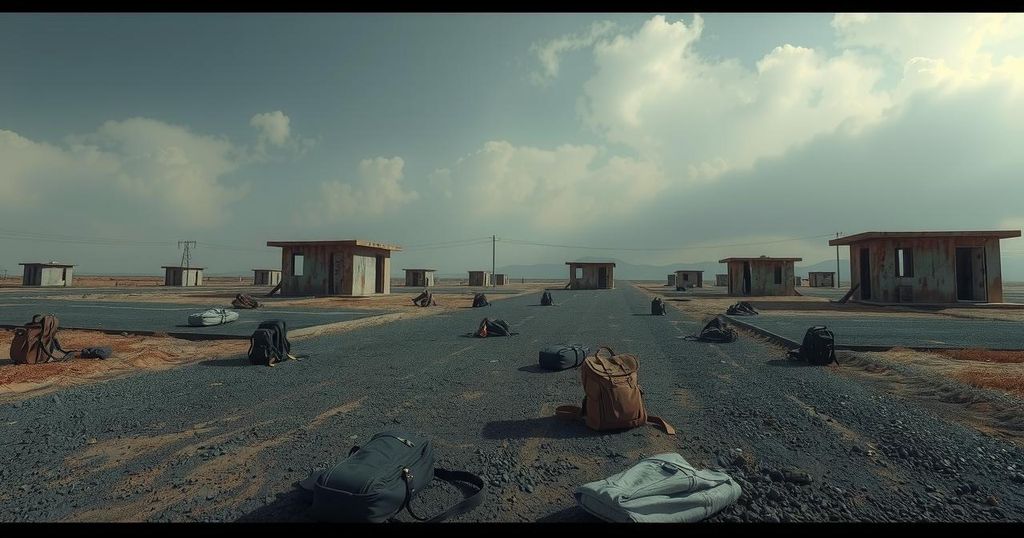The sudden evacuation of Iranian bases in Syria underscores a significant retreat of Iranian forces, once a crucial ally of Assad. Remnants of their presence, including military supplies and sensitive documents, tell a story of disorder and urgent withdrawal. Local perceptions of Iranian occupation are marked by resentment, coinciding with a strategic pivot towards Russian support as Syria’s new leadership emerges, indicating a complex geopolitical landscape.
The abandoned Iranian base in Syria reveals remnants of a hurried evacuation, including unfinished meals, discarded uniforms, and weapons. This site symbolizes a significant retreat of Iranian forces, who had maintained a prolonged presence in Syria amidst strategic alliances, notably with President Bashar al-Assad. Once a hub for Iran’s military operations, the base now tells a story of sudden abandonment as Iranian involvement faltered in the face of shifting dynamics.
Located near Khan Shaykhun in Idlib province, the base was previously vital for Iranian operations, housing the elite Islamic Revolutionary Guard Corps (IRGC) and various foreign militias. The entry to this camp is obscured, indicating a once heavily fortified location. Despite its strategic significance, the base’s disarray highlights the chaos during the retreat, with supplies indicating daily life into the final moments before abandonment.
Witnessed by armed Uyghur fighters from Hayaat Tahrir al-Sham (HTS), the site was once occupied by Iranian forces and has now become a new stronghold for these militants. Abandoned documents detail sensitive information regarding the fighters, emphasizing Iran’s extensive network in Syria, including Afghan brigades deployed there under the pretext of fighting Sunni extremism.
Iran’s rapid withdrawal was characterized by confusion and urgency, evidenced by last-minute orders for evacuation issued to the troops. Sources indicate that many forces retreated to Iraq or were relocated to Russian bases for extraction, reflecting a disorganized exit prompted by developments in the Syrian conflict. This retreat was further complicated by a breakdown of trust between Iranian-linked groups and the Assad regime.
Local residents recount the oppressive presence of Iranian forces in their communities, describing an environment filled with fear and restriction. Many locals felt controlled by the presence of Iranian militias, with reports of targeting anyone viewed as a threat. The withdrawal has resulted in mixed feelings among the populace, with relief at the departure of Iranian forces but lingering negative perceptions of their occupation.
Amidst this chaos, the newly empowered authorities in Syria have shown a clear shift away from Iran, implementing measures to restrict Iranian nationals from entering the country. This strategic pivot indicates a broader discontent with Iran’s influence, contrasting with a more favorable view of Russian support. Despite facing internal challenges, the new Syrian leadership has not entirely severed ties with Tehran, indicating a complex geopolitical reality.
As the base remains deserted, it stands as a testament to the decline of Iran’s military aspirations in Syria, with plans for expansion now halted. New construction efforts at the site signify the remnants of a once-ambitious campaign, now overshadowed by an uncertain future for Iranian interests in the region. The aftermath of the Iranian retreat leaves a lasting impression on the landscape and local sentiment, as the dynamics of power shift dramatically in Syria.
In summary, the abrupt abandonment of Iranian military bases in Syria signifies a dramatic shift in the region’s power dynamics. The hastily vacated sites, laden with remnants of military operation and strategic importance, highlight Iran’s diminishing influence. As local sentiments turn against Iranian forces, the newly established leadership in Syria seeks to assert its autonomy, distancing itself from Tehran while cautiously navigating relationships with external powers like Russia.
Original Source: www.bbc.com






